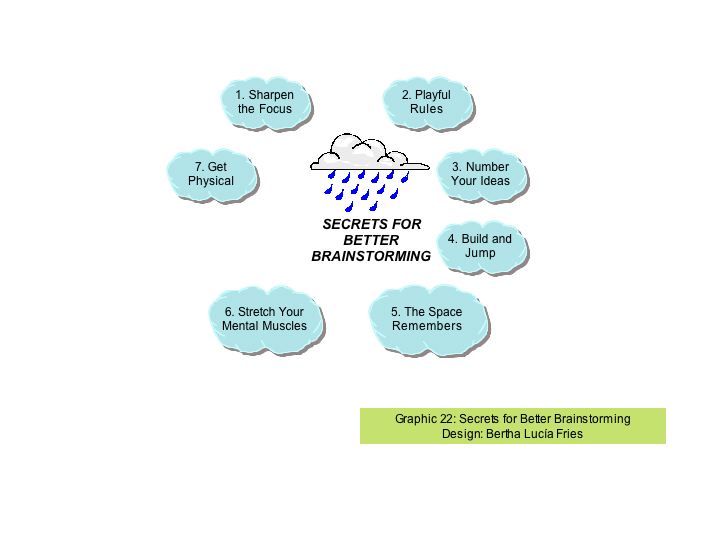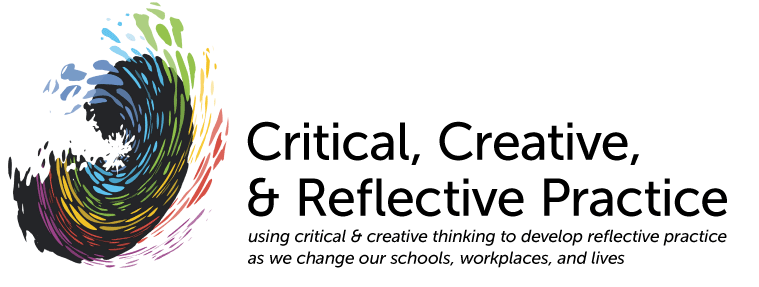Secrets for better brainstorming
(see Graphic 22)1. Sharpen the Focus
- Good brainstorming sessions start with a well-honed problem statement. This can be as simple as a question. Edgy is better than fuzzy. The session will get off to a better start - and you can bring people back to into the main topic more easily if you have a well articulated description of the problem at just the right level of specificity. A brainstorm without a clear problem statement is like a company without a clear strategy: you’ll wander aimlessly and need a lot of extra luck or talent to succeed. If you find yourself leading a session that lacks direction, spend a few minutes developing a good problem statement. It will be time well spent. Keep the problem statement open-ended and don’t already assume a particular solution.
- The best problem statements focus outward on a specific need or service enhancement rather than focusing inward on some organizational goal.
2. Playful Rules
- Don’t start to critique or debate ideas. It can sap the energy of the session pretty quickly. You need a way to turn aside critiques without turning off the critiquers completely. Some ideas to keep in mind, “go for quantity”, “encourage wild ideas”, “be visual.” Don’t allow the session to turn into a regular meeting. Don’t eliminate ideas that are “not possible” or that “didn’t work before”.
3. Number Your Ideas
- Numbering the ideas that bubble up in a brainstorm helps in two ways. First, it’s a tool to motivate participants before and during the session (“Let’s try to get to 100 ideas before we leave the room”), or to gauge the fluency of a completed brainstorm. Second, it’s a great way to jump back and forth from idea to idea without losing track of where you are. Numbering will also allow you to group ideas later to place them in like groups.
- A rate of 100 ideas per hour usually indicates a good, fluid brainstorming session. One hundred and fifty per hour is pushing the speed limit. Of course ultimately, it’s quality that matters, but it’s important to get a lot of ideas.
4. Build and Jump
- Watch for chances to ‘build’ and jump.’ High-energy brainstormers tend to follow a series of steep power curves in which momentum builds slowly, then intensely, then starts to plateau. The best facilitators can nurture an emerging conversation with light touch in the first phase and know enough to let ideas flow during the step part of the ideation curve. It’s when energy fades on a line of discussion that the facilitator really earns her keep. Try building on an idea. Encourage another push or introduce a small variation. Or take a jump, either back to an earlier path you skipped by too quickly or forward to a completely new approach. Whatever you do, try to get into the next power curve and keep the energy up.
5. The Space Remembers
- Great brainstorm leaders understand the power of spatial memory. Write the flow of ideas down in a medium visible to the whole group. Low-tech tools like Sharpie markers, giant Post-its for the walls, and rolls of paper with plenty of writing space. Brainstorming is an intensely group-oriented process, and the facilitator’s rapid scribing is one of the focal points that hold the group together. Capture ideas so that the group can see their progression and return to those that seem worthy of more attention.
6. Stretch Your Mental Muscles
It is worthwhile to do some form of group warm-up under the following conditions:o When the group has not worked together before.
o When most of the group doesn’t brainstorm frequently.
o When the group seems distracted by pressing but unrelated issues.
One type of warm-up is a fast-paced word game simply to clear the mind and to get the team into a more outgoing mode. These exercises help clear the mind and get the group ready to focus.
Another warm up is to do some content-related homework. Homework that is geared towards observing, handling, playing with, experiencing the object or area to be brainstormed significantly helps in quantity and quality of idea generation. Also, bringing ‘show-and-tell’ objects to a brainstorming session will help visualize the wide variety of options and materials that could be applied to the session’s topic.
7. Get Physical
Good brainstorms are extremely visual. They include sketching, mind mapping, diagrams and stick figures. You don’t have to be an artist to get your point across with a sketch or diagram. Leave your performance anxieties at the door and jump in with whatever visual tools you have available.The best brainstorming sessions often get physical. We move beyond two dimensions and push for three. The first way we do this is to bring in everything but the kitchen sink. That means competitive products, elegant solutions from other fields, and promising technologies that could be applied to the problem. The second way to get physical is to have materials on hand to build crude models of a concept, blocks, foam core, tubing, and duct tape, whatever might be useful. The third physical approach is ‘bodystorming,’ where you act out current behavior/usage patterns and see how they might be altered.

(Original page by Mary Frangie)
